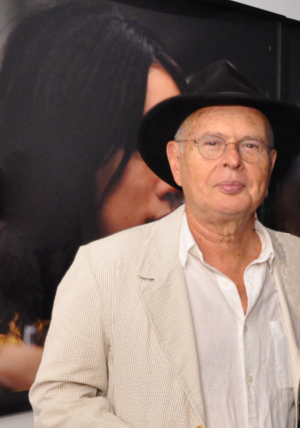|
Miguel da Silva Paranhos do Rio Branco (1946) is a painter, photographer, filmmaker, and creator of multimedia installations who currently lives and works in Rio de Janeiro. He worked extensively in Europe and the Americas since the beginning of his career in 1964 with an exhibition in Bern, Switzerland.
In 1966, he studied at New York Institute of Photography and, in 1968, the School of Industrial Design in Rio de Janeiro. He worked as a photographer and director of experimental films in New York from 1970 to 1972. He photographed and directed short films and features in the next nine years. . At the same pursuing own photographic career, he developed a working document of strong poetic charge. Soon, he became recognized as one of the best color photojournalists.
In 1980 Miguel Rio Branco had been acclaimed internationally for his films and photographs with awards, publications and exhibitions such as the Grand Prize of the First Triennial of Photography Museum of Modern Art in Sao Paulo and the Prix Kodak de la Critique Photographique in 1982 France, which he shared with two other photographers. His photographic work has been seen in several exhibitions in the last 20 years as the Centre George Pompidou, Paris, Sao Paulo Biennial, 1983; at the Stedelijk Museum, Amsterdam, 1989; at the Palazzo Fortuny, Venice, 1988; Burden Gallery, Aperture Foundation, New York, 1986; Magnum Gallery, Paris, 1985; MASP, São Paulo; Photogallery FUNARTE, Rio de Janeiro, 1988; Kunstverein Frankfurt, in Prospect in 1996; Museum of Modern Art in Rio de Janeiro, 1996.
Miguel Rio Branco has directed 14 short films and photographed eight feature films. His latest work as director of photography can be seen in the 1988 film, "An avenue called Brazil " by Otavio Bezerra. He won the award for best cinematographer for his work in "Living Memory" by Otavio Bezerra and "Abolition" at the Zozimo Bulbul Film Festival of Brazil in 1988. He also directed and photographed seven experimental films and two videos, including "Nothing will bring those who die when they procure should charge me in hell," which won the award for best cinematography at the Film Festival of Brasilia and the Special Jury Prize and International Critics Award at the XI International Festival of Documentary and Short of Lille, France in 1982.
Rio Branco's photographs were published in various magazines like Stern, National Geographic, Geo, Aperture, Photo Magazine, Europeo, Paseante. Sudor Dulce Amargo, the first book of Rio Branco was published in 1985 by the Economic Culture Fund, Mexico . The second, Nakta with a poem by Louis Calaferte was published in 1996 by the Cultural Foundation of Curitiba. In 1998 he released two books: Miguel Rio Branco, with essay by David Levi Strauss, published by Aperture and Silent Book, by Cosac Naify.
Miguel Rio Branco has works in European and American public and private collections, including the following institutions: Museu de Arte Moderna do Rio de Janeiro, Museum of Modern Art in Sao Paulo, the Museu de Arte de Sao Paulo, Centre George Pompidou in Paris, San Francisco Museum of Modern Art, the Stedelijk Museum in Amsterdam, the Museum of Photographic Arts of San Diego and the Metropolitan Museum in New York.
|
|

Works:
|
